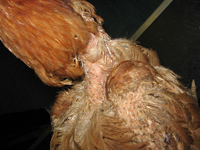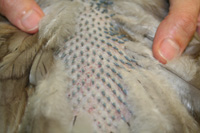Behaviour Chickens do not have much sense of taste or smell but they are sensitive to texture. They use shadows to spot potential food items on the ground and anything falling or moving is immediately investigated. All birds have colour vision and hens are particularly attracted to red, hence the red bases to chick drinkers. Unfortunately this also means that any fresh blood is also attractive which can lead to cannibalism, no matter how large the free-range, but once the blood has dried the danger is usually past. Hens are not very good gardeners – they seem to be convinced that everything you have planted is upside down. What they don’t scratch up, they dust bathe in to help remove external parasites. They will scratch dust (or dry ashes or sand) and flip it with their wings all over themselves then stand up and shake it all out. Hens will also sunbathe, lying stretched out with leg and wing extended, to all extents dead, but merely sunbathing. They do this in order to get the sun to change the oil from the preen gland (just above the tail and the size of a biro-point) which they have wiped over their feathers when preening, in to active vitamin D. Vit D is important for bone strength.
Anything overhead or flying is a potential predator – one bird will often alert the breeder to a sparrowhawk or buzzard and then there is a general warning buzz. Hens do not see well in the dark so they feel safe in a dark enclosed space at night putting themselves to bed before twilight, but they do not herd well, even in daylight; two long bamboo canes can work wonders in getting them all to go in the desired direction. Good feather condition is important for insulation and moulting occurs once a year, generally in the autumn taking 2-3 weeks, good and correct nutrition being helpful at this time. The colour of feathers can fade in sunlight over the summer months. The shape of the chicken does not change if it has gained or lost weight, so regular handling is important to check your chickens’ health. Feathers can be raised or lowered indicating mood and behaviour.
Hens are programmed to moult all their feathers once a year. It takes 3-4 weeks for a new set of feathers to grow. The hybrids sometimes moult only every 18 months and stress can cause a premature moult. The old feathers are pushed out by the new ones coming through and in a specific pattern, usually not all at once, although the better hybrid layers may look like a hedgehog for a week or two. The new feathers have blood in them until they are fully through and then the blood is resorbed.
Chickens are creatures of great habit – life is safer that way – so any change in routine can upset them. This can range from a sudden snowfall, when they will not venture outside as the ground has changed colour to a sudden change from meal to pellets one of which does not look like food. This is not stupidity: their confidence is easily dented, which of course is part of the survival mechanism. The key word here is sudden: they will cope with most changes if they are gradually implemented. The word “henpecked” is so much part of our language that most would use it without thought to its origin, but the pecking order is a vital component in maintaining the stability of the flock in hens. With or without a cockerel, hens have a strict hierarchy and territory which only changes if a bird is removed or is sick. How then do you return a recovered bird to a small flock? With great care and supervision, as their memory is short and the whole structure has to be reshuffled. The recovered bird must be fully fit in order to reclaim her place. If hens fight, the cockerel will usually break it up. Should you wish to add say, three or four new laying hens to an established flock, the least traumatic way to do it is to turn their liking for routine against them and put old and new into a fresh henhouse so no-one has established a territory. Or put new hens in a dog crate within the hut/run for a couple of weeks, which will allow the residents to get used to the idea of new flock members without being able to beat them up, before letting them mix. Young, unconfident laying hens cannot be expected to start or continue to lay if being bullied by the rest of the established and confident flock: the youngsters can quite easily be killed by the matriarchs. The skin of hens is thinner than mammals’ and is normally white (e.g. Sussex), yellow (e.g. Rhode Island Red) or black (e.g. Silkie). Leg colour depends on plumage colour and breeding cockerels have a red blush down their legs. Yellow leg colour can fade if a hen has been laying well as the pigment goes into the yolk. If feathers are missing off the back of a hen, it is usually due to the feet of the cockerel when he is mating. If her feathers are missing on the front of her neck or under her tail, it will be her friends who are pulling them out – the alpha hen is not able to be pecked by the lesser ones – she may even be the perpetrator! Should you need to contain a bird behind a lowish fence, it is permissable to clip the feathers on one wing, making flight unbalanced and therefore difficult. One wing, after the moult so the blood in the growing feather has gone back in to the hen leaving the quill pale and empty, is clipped as per the diagram with scissors, using the small feathers as a guide so that the cut is far enough away from the skin but enough feather taken off to prevent flying. Cutting feathers is just like cutting our nails as feathers and nails are made of keratin. Hens are very good at jumping, however, and may still get over a fence, the grass always being greener on the other side.
|






